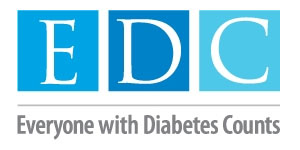
Reducing Disparities in Diabetes Care
Ethnic and racial minorities have a higher prevalence of diabetes than Caucasians. We want to change that. Think of us as your local “go-to” experts for supporting quality improvement initiatives that reduce disparities among underserved populations and promote population health.
Diabetes self- management education (DSME) is a proven intervention for empowering persons with diabetes to acquire the knowledge and skills necessary to improve the quality of their lives. DSME prevents/lessens the severity of complications resulting from diabetes such as kidney failure, amputations, loss of vision, heart failure and stroke.
Using lessons learned from the Everyone with Diabetes Counts program, Qsource works with providers to educate them on the Medicare DSMT (diabetes self-management training) and MNT (medical nutrition therapy) benefits. In the states we serve, train-the-trainer programs increase the numbers of certified diabetes educators (CDEs) and community health workers (CHWs).
Our goals are to work with providers to:
- Improve clinical outcomes of HbA1c, lipids, blood pressure and weight control for people with diabetes;
- Decrease the number of patients who require lower extremity amputation due to complications resulting from poorly controlled diabetes;
- Improve health literacy of Medicare and dual-eligible patients with diabetes in targeted populations by providing and facilitating DSME training classes;
- Increase adherence to clinical guidelines by participating practitioners for appropriate use of utilization measures for HbA1c, lipids, and eye exams.
Which initiatives are right for you?

Featured Resources
Contact Us
You can also search our comprehensive library of online resources, where you can sort by Qsource state, initiative, patient or provider focus or simply type in a keyword for quick access to the tools and resources you need.
Making the Annual Wellness Visit (AWV) Work for You
Diabetic Eye Disease toolkit (Spanish and English)
Aging and the Eye: complete list of resources (teaching modules, handouts, articles, fact sheets, infographics)
See Well for a Lifetime Toolkit
Module 1 Making Vision a Health Priority
Module 2 Age-Related Eye Disease and Conditions: Macular degeneration, glaucoma, cataracts, diabetic eye disease, dry eye, and low vision
Module 3 Low Vision: This is a slide presentation that provides an overview of low vision, including causes, symptoms, and treatment. The presentation also covers how vision rehabilitation services and assistive devices can help people with low vision maintain their independence and quality of life.
Living with Low Vision education module
Diabetic Eye Disease Self-Guided Module
Age-Related Eye Diseases and Conditions
Healthy Vision Starts with a Dilated Eye Exam – explains what happens in a dilated eye exam
Everyone’s Vision Can Change with Age – states what changes are normal and what are not
Financial Assistance for Eye Care
Infographics on eye health
The 2018 Standards of Medical Care in Diabetes
QIO Program Business Plan Guide for DSME Programs, Nov 2016
CMS DSMT Helpdesk eEmail
CMS DSMT Accreditation
Healthy Eyes Matter
Healthy Eyes Matter (Spanish)
Healthy Teeth Matter
Healthy Teeth Matter (Spanish)
Healthy Feet Matter
Healthy Feet Matter (Spanish)
All Medicines Matter
Toolkit: Four Times When a Referral for DSMES Is Needed
Guidance on Care Management Services for Physicians
Connected Care Campaign Resource Hub
AADE’s new Diabetes Goal Tracker mobile app
Overview of Everyone with Diabetes Counts
American Diabetes Association
American Diabetes Month
Diabetes programs, materials and studies from the CDC
Do I Have Prediabetes?
CDC’s Division of Diabetes Translation
National Diabetes Prevention Program
Become an American Kidney Fund Kidney Heath Educator
Kentucky Diabetes Network
AHRQ Health Literacy Universal Precautions Toolkit
Kentucky Diabetes Resource Directory
Every Body Walk
The Centers for Disease Control and Prevention nutrition resources
Choose My Plate resources
Nutrition.gov resources
Academy of Nutrition and Dietetics resources
Physical Activity Guidelines for Americans
Academy of Nutrition and Dietetics
Indian Health Services Division of Diabetes Treatment and Prevention
Diabetes Self-Management Education and Support for Adults with Type 2 Diabetes: ALGORITHM of CARE
National Eye Institute at 50: Leading the Fight Against Blindness
Shared Medical Appointments
Annual Diabetic Foot Exam Demonstration
Annual Diabetic Foot Exam, June 2017
An eight-minute video demonstrating the three-minute comprehensive foot exam done by a primary care physician on one of his type 2 diabetes patients.
Diabetes: Protect Our Future
What is a Diabetes Educator?
Take the Prediabetes Risk Test
Bacon Lovers | Type 2 Diabetes Prevention
Busy Moms | Type 2 Diabetes Prevention
Mama Ocupada | Type 2 Diabetes Prevention
Living with Diabetes
“I’ll pass my knowledge on to others” Diabetes Self-Management Education (DSME)
Nearly one-third of persons 65 years and older have diabetes. It is the most common cause of blindness, kidney failure, and amputations in adults. In this two-minute video, one Mississippi man shares how he learned the importance of taking an active role in controlling the disease. Hear how he got the knowledge and skills to improve his quality of life by participating in a free Diabetes Self-Management Education (DSME) class.
Patient Education
Patient Insight: Depression and Diabetes
Qsource Pinterest Board: Diabetes Management
The QIO Program helps you embrace data in your healthcare setting
Failure Modes & Effects Analysis (FMEA)
The QIO Program shares 5 steps in the Failure Modes and Effects Analysis (FMEA) to anticipate potential problems before they occur
Root Cause Analysis (RCA)
The QIO Program demonstrates how to identify the root cause of a problem using The 5 Whys
QIO Documentary
Learn about the history of the QIO Program, from 1966 through today.
IHI Whiteboard: Model for Improvement, Clip 1
IHI Whiteboard: Model for Improvement, Clip 2
IHI Whiteboard: PDSA Cycles, Part 1
IHI Whiteboard: PDSA Cycles, Part 2
IHI Whiteboard: Cause & Effect Diagrams
 Skip to main content
Skip to main content








